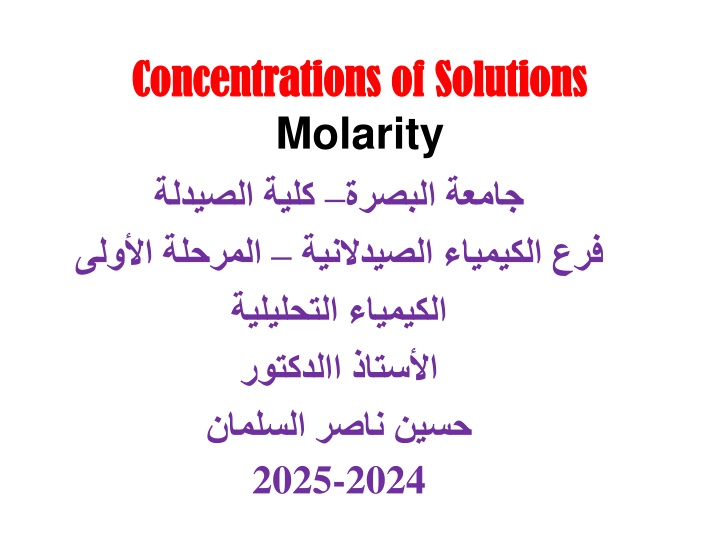
Understanding Solution Stoichiometry in Chemistry
Explore the concepts of solution stoichiometry in chemistry, including molarity calculations, interconverting moles and volume, solution stoichiometry practice questions, and more. Learn how to determine concentrations of aqueous solutions and conduct titrations for acid-base reactions.
Download Presentation

Please find below an Image/Link to download the presentation.
The content on the website is provided AS IS for your information and personal use only. It may not be sold, licensed, or shared on other websites without obtaining consent from the author. If you encounter any issues during the download, it is possible that the publisher has removed the file from their server.
You are allowed to download the files provided on this website for personal or commercial use, subject to the condition that they are used lawfully. All files are the property of their respective owners.
The content on the website is provided AS IS for your information and personal use only. It may not be sold, licensed, or shared on other websites without obtaining consent from the author.
E N D
Presentation Transcript
Concentrations of Solutions Concentrations of Solutions Molarity 2025-2024
More Practice Q.1 How many grams of CuSO4are needed to prepare 250.0 mL of 1.00 M CuSO4? Given: 250.0 mL soln 1.00 M CuSO4 Find: g CuSO4 Use: mol CuSO4 = molarity x volume Molarity = mol / 1L Vol = 250.0 mL
Concentration of Solutions Interconverting Molarity, Moles, and Volume g CuSO4 = 250.0 mL soln x 1 L x 1.00 mol 1000 mL 1 L soln x 159.6 g CuSO4 1 mol = 39.9 g CuSO4
Solution Stoichiometry Remember: reactions occur on a mole to mole basis. For pure reactants, we measure reactants using mass For reactants that are added to a reaction as aqueous solutions, we measure the reactants using volume of solution.
Solution Stoichiometry Practice Q.2 If 25.0 mL of 2.5 M NaOH are needed to neutralize (i.e. react completely with) a solution of H3PO4, how many moles of H3PO4 were present in the solution? 3NaOH (aq) + H3PO4 (aq) Na3PO4 (aq) + 3H2O(l) Given: 25.0 mL 2.5 M NaOH balanced eqn: 3 mol NaOH/1 mol H3PO4 Find: moles of H3PO4
Approach Molarity moles NaOH Vol NaOH Soln NaOH 2.5 M (=mol/L) Molar ratio 0.025 L NaOH soln 3 mol NaOH/1 mol H3PO4 moles H3PO4 25.0 mL NaOH soln 1L 2.5 mol Mol NaOH = 25.0 mL x x = 0.0625 /3 =0.02 mol H3PO4 1000 mL 1 L
More practice Q.3 What mass of aluminum hydroxide is needed to neutralize 12.5 mL of 0.50 M sulfuric acid? Next slide
2Al(OH)3 + 3H2SO4 = Al2(SO4)3 + 6H2O n = M X V (L) 0.5 M X 0.0125 L = 0.00625 mole ( acid) 2/3 x 0.00625 = 0.00416 mole , Al(OH)3 W = n x M Wt. = 0.00416 x 78 g/mol.= 0.37 g
Solution Stoichiometry Solution stoichiometry can be used to determine the concentration of aqueous solutions used in reactions. Concentration of an acid can be determined using a process called titration. reacting a known volume of the acid with a known volume of a standard base solution (i.e. a base whose concentration is known)
Practice Q.4 If 35.50 mL of 2.5 M NaOH are needed to neutralize 50.0 mL of an H3PO4 solution, what is the concentration(molarity) of the H3PO4 solution? 3NaOH (aq) + H3PO4 (aq) Na3PO4 (aq) + 3H2O(l) Given: 35.50 mL 2.5 M NaOH 50.0 mL of H3PO4sol n Find: molarity (mol/L) H3PO4
Mol H3PO4 = 35.5 mL x 1 L x 2.50 mol NaOH x 1 mol H3PO4 1000 mL 1 L 3 mol NaOH = We re not done .we need molarity. 0.0296 mol H3PO4
Molarity of H3PO4 Molarity = moles L = 0.0296 mol H3PO4 x 1000 mL 50.0 mL L = 0.592 M H3PO4
